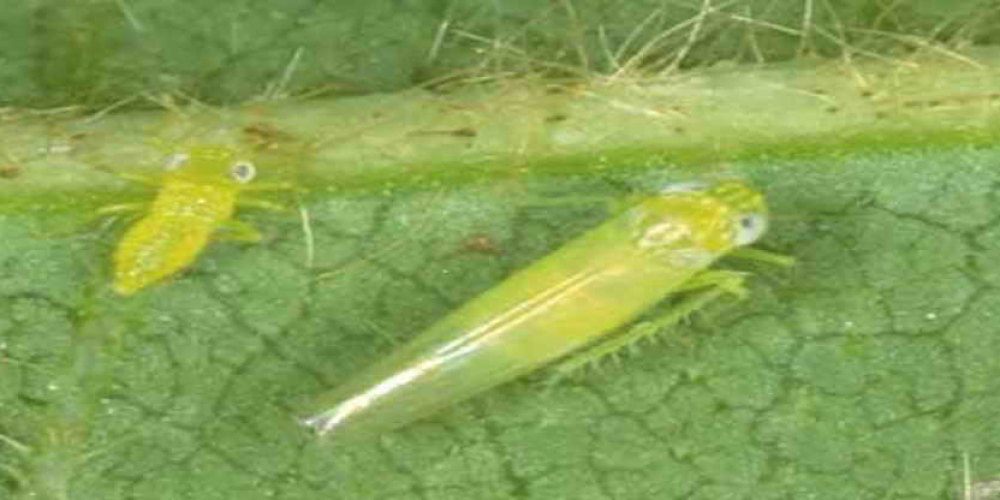Table of contents of the article
Toggle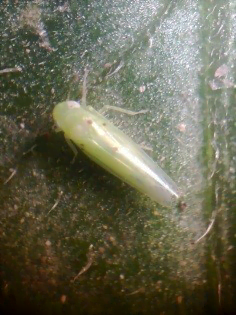
Jassids (leafhoppers) pose a major threat to agricultural plants by sucking their sap. In this article on your website, World of Plants, we discuss the best methods of prevention and treatment.
Introduction to Jassid insect (leafhoppers): Leaf Hoppers or Empoasca discipiens Paoli
- This insect is considered one of the most dangerous insects that infect eggplant, as the infestation begins in the nursery and in permanent land, where the insect appears from the month of April until the end of the eggplant season (November).
- Adults and nymphs feed on plant sap, which turns the affected area yellow, then brown, and causes wrinkling, yellowing, and curling of the leaves. Gassid insect.
- The infestation is characterized by the presence of insects on the lower surface of the leaf, which are green in color and move along the leaf in a distinctive lateral movement. * The insect transmits viral diseases to eggplant plants, such as curling and yellowing of eggplant leaves.
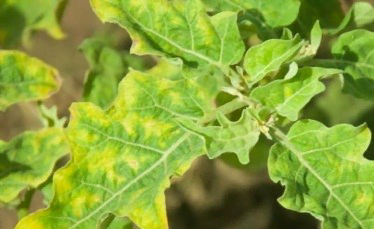
Characteristic symptoms
Symptoms are seen in the form of yellow spots on the edges of the leaves, then they spread to all parts, and they turn brown like burns, wrinkle, dry, and fall off as the infection progresses, with the wilting of the young plants. Insects are seen on the lower surface of the leaves, and when the plants are shaken, they fly away, while the small nymphs hide in the edges of the leaves and the tubers resulting from the plants. Infected plants are soft due to low levels of protein and potassium, and when used as seeds in agriculture, the germination and growth rate is weak.
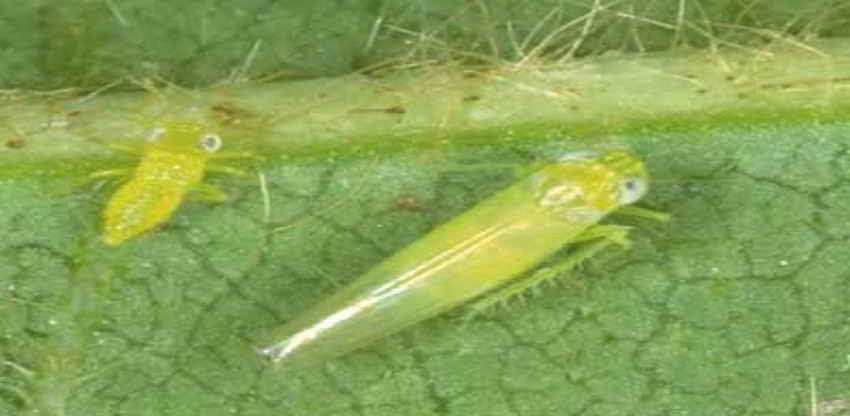
Symptoms of infestation and damage of the Jassid insect (leafhoppers)
Gassid feeding on the sap of sugar beet plants causes pale spots as a result of the removal of chlorophyll from the leaves. Yellow spots appear with wrinkles and brown discoloration of the leaves at the edges, extending inward until the surface of the leaf gradually darkens and appears with a burnt color called “hopper burns,” then it dries up and falls off.
Leafhoppers cause great damage to sugar beet plants, as they transmit viral diseases to the sugar beet crop. They are second only to aphids in being more dangerous to beets, as they transmit sugar beet top curl disease in North America, and this disease has not been discovered in Egypt currently.
Due to the recent cultivation of sugar beets in Egypt, no clear individual of leafhoppers feeding on the sap of sugar beet plants has emerged currently, but there is no harm in studying one of these leafhoppers located in the United States that is responsible for transmitting the leafhopper disease in beet plants.
They are piercing, sucking insects that feed on plant juices. The general shape of these insects is spindly, wedge-like, and they are found on the lower surface of sugar beet leaves. When the plants are shaken, the juvenile insects jump or fly, while the long-legged nymphs run sideways to the edges of the leaves to hide. These insects are present throughout the year and are abundant. Jassid numbers occur in the fall months of September through December as well as in the spring.
Females lay their eggs inside the leaf tissue in early spring. The nymphs emerge from the eggs after about 10 days, and molt five times to turn into juvenile insects after about two weeks. Both nymphs and juveniles feed on the lower surface of beet leaves by sucking the plant’s sap.
Leafhoppers have (3-4) generations per year.
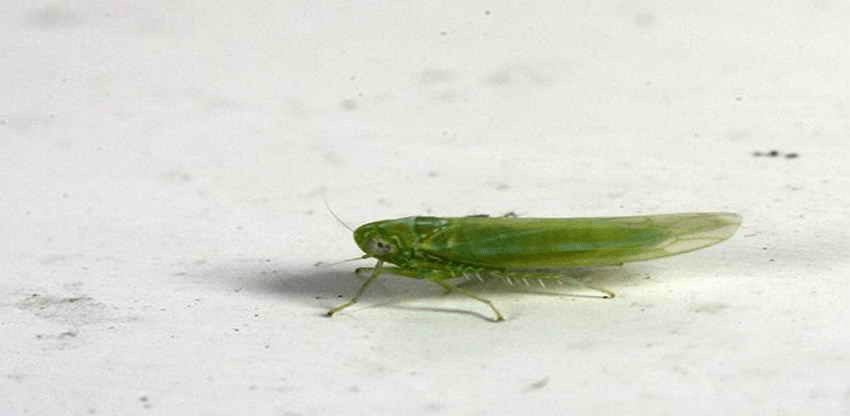
Preventive control of Jassid insect (leafhoppers)
Preventive control is carried out by the farmer avoiding high plant density in the fields of the Solanaceae family, as it encourages the reproduction and transmission of pests, prevents ventilation and breathing of the plants, and increases the chances of infection by thrips and insects. Eggplant must also be planted at appropriate distances, which are 80-90 cm between the lines and 70 cm between the plants. The farmer also completely gets rid of weeds in the eggplant field, and takes care of irrigating the field in a balanced manner. Also, increased humidity in eggplant fields encourages thrips infection. Therefore, the farmer reduces humidity as much as possible by not increasing irrigation beyond its limit. Irrigation must be regular, as it is preferable to use drip irrigation and the method of fertilizing with fertilizers dissolved in the irrigation water. This increases the resistance of plants. Eggplant.
Curative control of Jassid insect (leafhoppers)
Therapeutic control is carried out as soon as the danger requires the use of the pesticide in eggplant fields, i.e. symptoms of infection appear that make the numbers of the insect community dangerous, where control is carried out through one of the phospho-organic pesticides. Dimethoate can be used by spraying on the leaves and branches of eggplant. The pesticide Malathion also gives good results in infected eggplant fields, especially if other pests interfere with thrips, such as aphids and scale insects. The pesticide Parathion-methyl or Metacystox can also be used by spraying on the affected parts of branches, leaves, and fruits.
Pesticide use cycle
In order to prevent pest resistance to pesticides in eggplant fields, we resort to applying a pesticide application cycle, whereby in the first season of thrips infestation, the pesticide Dimeton-S-Methyl or Dimeton is used. In the following season, the pesticide Parathion methyl is used by spraying on the leaves, fruits and branches of eggplant, and in the third season the pesticide is Malathion, making sure to spray in mid-spring at the beginning of May. In addition, the previous ring itself must be changed every 9 years for precise control and so that thrips do not form resistant strains in infected and infected eggplant fields.
Integrated field management programme
1. Basic procedures
Integrated management of eggplant thrips is carried out through a combination of agricultural, mechanical, therapeutic and care measures. The farmer relies on an initial deep plowing of the eggplant soil of about 25-35 cm, followed by a shallow plowing of 10-14 cm to soften and break up the soil and get rid of the pupae and eggs of pests, including thrips. Special cardboard or wooden traps are also used and distributed in the eggplant and vegetable field to catch tunneling moths such as the European corn borer, the tomato leaf miner, Tuta absulota, the cotton bollworm, Helicoverpa armigera, the fruit worm, the tomato moth, and others.
2. Supportive measures
The farm depends on using fermented local fertilizer for a period of no less than 6-8 years, then spreading it and distributing it in the eggplant fields, and fertilizing it with nitrogen in three batches. Also, the farmer uses fungicides to eliminate fungi that love moisture, because the presence of thrips encourages fungal diseases, by using the pesticide Mancozeb funjacide on eggplant leaves and branches. The farmer also takes care, as much as possible, to avoid plant density in the eggplant fields and give enough food space for each individual plant to get its share of ventilation, food, lighting, fertilizer and water.
Thus; We have learned about eggplant thrips and the extent of its danger if the infection worsens within the fields of the nightshade family. The farmer will also have learned about the means of prevention and possible treatment for this thrips and the management program applied in the infected eggplant field, as this thrips causes significant damage to field eggplant cultivation and must be dealt with.
In conclusion, we would like to note that we, at the world of plants website, offer you all the necessary services in the world of plants, we provide all farmers and those interested in plants with three main services::-
- Artificial intelligence consulting service to help you identify diseases that affect plants and how to deal with them.
- Blog about plants, plant diseases and care of various crops ... You are currently browsing one of her articles right now.
- An application that provides agricultural consultations to clients, as well as a service for imaging diseases and knowing their treatment for free – Click to download the Android version from Google Play Store، Click to download the IOS version from the Apple App Store.
Sources:
Vegetables - tomatoes - insect pests - jacids - agricultureegypt
Sugar beet insects (leafhoppers (jassids)) - almerja




